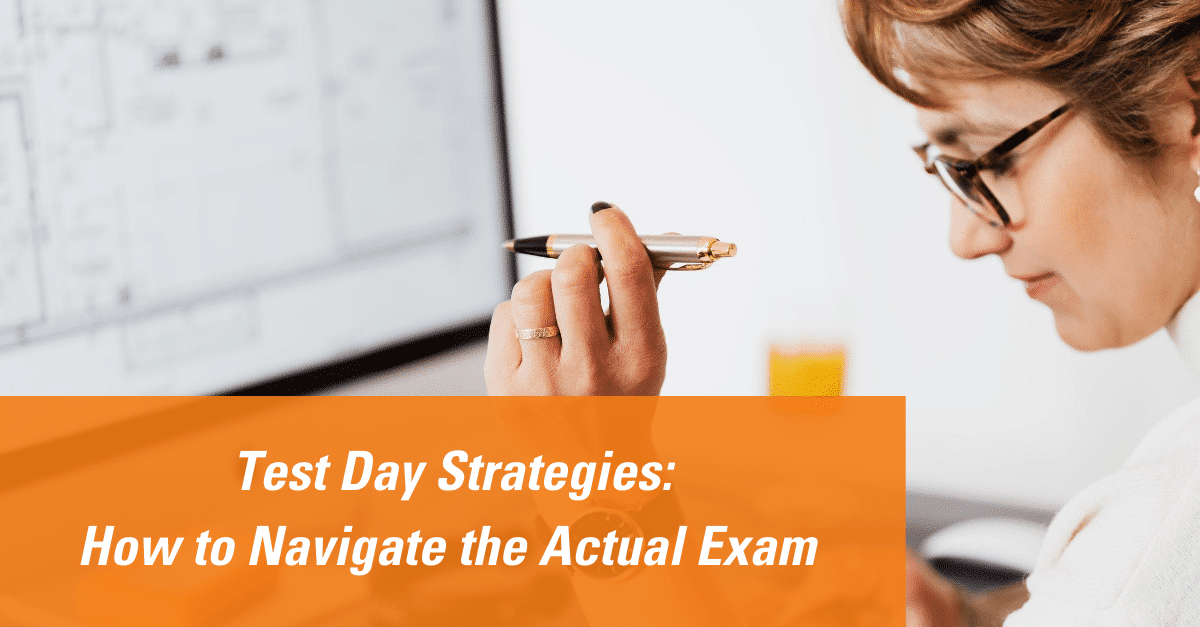You have studied. You have practiced. You know the material backward and forward. You’re prepared for questions on every topic and in every possible format. It’s now time to plan for how to take the test on exam day. Unlike your study days, the exam is timed. You have four hours to complete the exam. Every question, blank, or line that is left unanswered is points left on the table. To ensure that you are best positioned to excel on exam day follow our simple mantra, don’t panic. Don’t rush. Don’t stop.
General test-taking strategies
Trust your instincts. Your first answer is often your best attempt. Only go back and change an answer if you know for certain you were wrong with your initial attempt. For example, if I answer a question and then find the correct answer in a different question, I should change my initial response. However, do not go back strictly because you were unsure. Trust your instincts. Stick with your first response.
Answer the questions, simulations, line items, or blanks you know for certain first. You never want to run out of time by leaving questions you could have answered unanswered. Do those first, then go back to the ones you were not certain of or need to guess.
Multiple-choice questions (MCQs)
Your exam will consist of either 62 (BEC), 66 (FAR), 72 (AUD), or 76 (REG) MCQs. Aim to spend a maximum of one-and-a-half to two minutes total per question, although you should aim for even less – 60 seconds would be best. If you spend more time per question in REG, you will spend approximately two hours on MCQs, leaving only two hours for eight task-based simulations. There is a strategy in timing.
For long MCQs (more than 5-6) lines, flag them, skip them (briefly), and come back to them after answering the shorter ones. This will allow you to better manage your time because on these longer MCQs, even reading the question can take a minute or two.
Read what the question is asking before reading the entire question. This can usually be found in the last sentence of the question text. You may not need the information in the text, and even if you do, knowing what the question is will make you aware of what you are seeking as you read the question.
If you do not know an answer, don’t panic. First, try and narrow the options down from four to two options. With most questions, you can eliminate two answers almost immediately. For example, if you know rising expenses decrease profits and two of the options list profit as increasing, you can eliminate those two wrong options. Then, 50/50 odds are good. Once you get there, guess! Wrong answers count the same whether you leave the question blank or guess wrong. By guessing, you are giving yourself an opportunity to get points. You should flag the question in case a future question triggers your memory. Otherwise, don’t stop.
Read every answer choice before submitting your question. Many questions contain multiple correct answers and require you to choose the best option of multiple correct options. The first correct answer may not be the best correct answer. This is most common in AUD and BEC.
Per section, 12 MCQs will not count. They are what the AICPA calls “pretest questions” and are not part of your final score. You will not know which questions pretest and which questions are actual test questions. Proceed through the exam as if every question counts toward your score.
Task-based simulations (TBSs)
Once you complete the MCQs it is time for the TBSs and written communications (BEC only). Just like with the MCQs, there is no additional penalty for attempting and answering the question wrong relative to leaving it blank. Don’t leave an answer choice blank if you have any time left. In the worst-case scenario, you should enter “0” if the question is a monetary question or the filler answer (e.g., “no solution” or “none of the above”). Here are the steps you should follow when answering the TBSs:
- Fill in as much as you can on a first pass without using the guide or reference materials.
- Only after completing (1) should you use the reference materials to answer the portions of the simulations that you could not answer on your own.
- Only after completing (2) should you use the reference materials to check your work or answers that you answered on your own.
It is in our nature to make sure everything we do as accountants is accurate. In your daily work and study habits, that is a great way to proceed. On the exam, it can cost you points. Only go back and check your work once you have answered every blank in every simulation and have exhausted all your options on the questions or tasks that you were less confident in. Do not start checking your work when you have unanswered blanks.
Per section (1) TBS is a pretest simulation and will not count toward your score. Like the MCQ section, you will not know which TBS is a pretest question. Treat every simulation like it counts.
Other helpful strategies
Practice like you play and play like you practice. If you are most comfortable studying in certain clothes or certain shoes, wear those on test day. If you routinely have the same breakfast, have that on test day. Don’t alter your routine.
When possible, schedule your exam for a time that best matches your peak performance. If you do not study at 8 a.m. or usually take 8 a.m. classes, you shouldn’t sign up for an exam at that time. If you are most aware and focused around noon, schedule your exam for that time. Use the schedule to match your strengths.
Remember, don’t panic. Don’t rush. Don’t stop.





